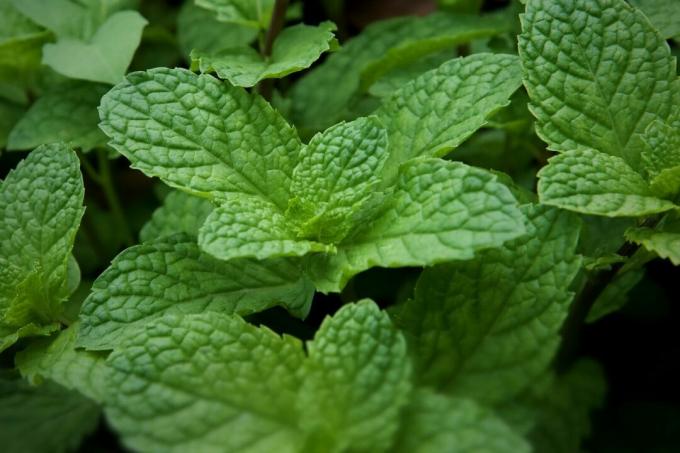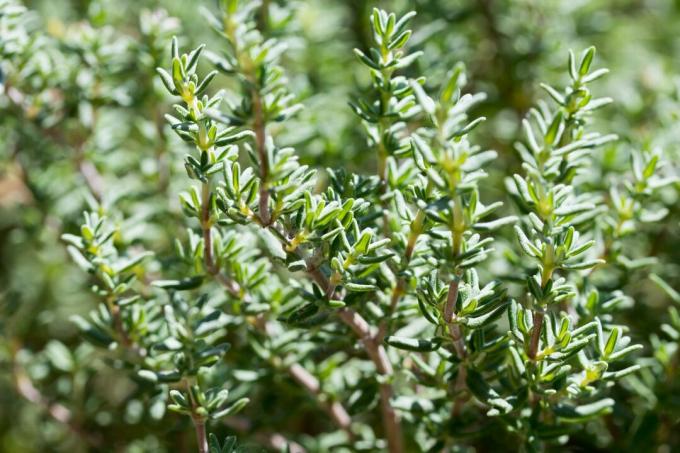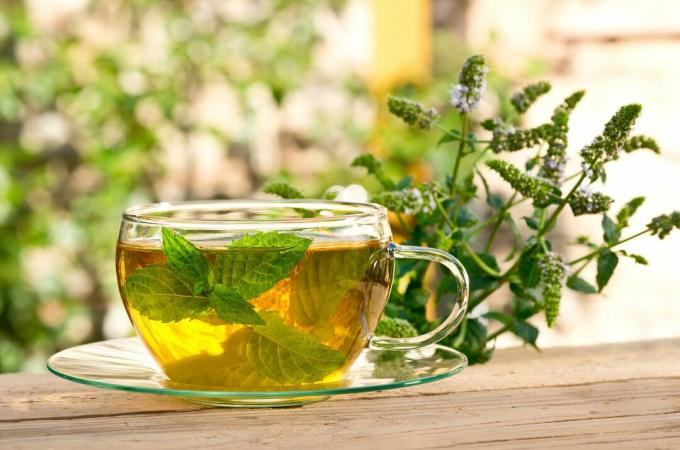There are many herbs that grow in your garden that you can use to make your own tea blends. You can find out what they are and the recipes here.

When it gets cold outside, there is hardly anything more beneficial than a warm cup of herbal tea. However, this tea has nothing to do with the usual black or green tea. Rather, it is an infusion of plant parts whose active ingredients are dissolved in hot water. You might even find one or the other herb that is suitable for making tea in your garden. Here you will find out which herbs are ideal for tea blends you have made yourself and you will also find some recipe ideas that you can implement right away.
contents
-
The best herbs for tea blends
- 10. Lemon Balm (Melissa officinalis)
- 9. Mint (Mentha sp.)
- 8. Sage (Salvia officinalis)
- 7. Chamomile (Matricaria recutita)
- 6. Thyme (Thymus vulgaris)
- 5. Lemon verbena (Lippia citriodora)
- 4. Damask Rose (Rosa damascena)
- 3. Marigold (Calendula officinalis)
- 2. Cheese poplar (Malva sp.)
- 1. Bee balm (Monarda didyma)
- Make your own herbal tea blend
-
Recipes for tea blends to try
- Recipe 1: Feel Good Tea
- Recipe 2: Free Breath Tea
- Recipe 3: bedtime tea
The best herbs for tea blends
There are a variety of herbs that are suitable for preparing aromatic teas. Knowing how the individual herbs work and how they are used can make it easier for you to put together a harmonious tea blend. Below you will find suitable herbs for your tea blend.
10. lemon balm (Melissa officinalis)
the lemon balm has a relaxing, stress-relieving and mood-enhancing effect. A tea of the leaves has a calming effect on insomnia and depressive moods. Its antiviral effect also makes it the ideal winter tea. But even in summer, an infusion of the leaves tastes wonderful as a refreshing iced tea. the Lemon balm harvest should definitely be done before flowering, because after that their taste becomes unpleasant.
9. mint (Mentha sp.)
There are a multitude of different ones types of mintthat are suitable for tea blends. The aromatic ones are often used peppermint, the milder apple mint, the dark chocolate mint or the exotic pineapple mint. Mint has a cooling and refreshing effect. The menthol contained helps against blocked noses and sinus infections. The aromatic tea is therefore a popular drink for sore throats, colds and headaches. It is also said to relieve indigestion and stimulate digestion. However, the tea is not suitable for children and nursing mothers.

8. sage (Salvia officinalis)
the sage is a tasty and popular tea herb during the cold season. The tannins it contains strengthen the mucous membranes and thus help with inflammation in the mouth and throat area. But Caution in pregnancy: Sage can inhibit milk production and should therefore be avoided during pregnancy and breastfeeding. For an aromatic tea, harvest the young leaves before they bloom.
7. chamomile (Matricaria recutita)
From May to July exudes the chamomile their unmistakable scent. The tea can help with insomnia and ensures healthy digestion. But chamomile is not just one of them Herbs to sleep with: The tea is also said to reduce the effects of stress and anxiety. If you have a cold, you can increase its effect with a little honey and lemon juice. The sweet and tart taste makes the tea very popular with children. Only the delicate flower heads are harvested.
6. thyme (Thymus vulgaris)
the thyme is often used for seasoning in the kitchen. However, its effect and aroma are also wonderful in a tea blend. It is not for nothing that thyme is a component of many cough syrups and cough drops. It has an antimicrobial, expectorant effect and supports expectoration. The lemon thyme (Thymus citriodorus) is a hybrid form, which is also wonderfully suited as a tea herb.

5. lemon verbena (Lippia citriodora)
The South American sister of the native Verbena exudes its aromatic scent of lemon at the slightest touch. In summer you can prepare a refreshing iced tea from the fresh leaves. the lemon verbena has a relaxing, calming and appetizing effect. A tea made from the leaves is said to lift the spirits and promote a deep, restful sleep. In France, the traditional bedtime tea is called "Verveine".
4. Damask rose (Rosa damascena)
the rose Although it only has a limited healing effect, the petals in the tea can lift the mood simply by their color and scent. The ripe fruits are harvested from September, cut in half and dried in a slightly open oven at 50 °C. the rosehips contain a lot of vitamin C to strengthen the immune system. They make a delicious, fruity tea for the cold winter months.
3. marigold (Calendula officinalis)
the marigold is a diverse medicinal plant that has been used to treat a wide variety of ailments since the Middle Ages. Among other things, it has an anti-inflammatory effect and helps with digestive and menstrual problems. The whole flower heads or the individual petals are harvested. They used to be sold as "false saffron" because of their yellow color.

2. cheese poplar (Malva sp.)
The flowers and leaves of the cheese poplar contain mucilage, which has an irritating and pain-relieving effect on inflamed mucous membranes. For a cough tea, leave them in the cold infusion for several hours (do not boil). You can then warm the tea slightly and drink it in sips. The Large Cheese Poplar (Sylvestris) and the small cheese poplar (M neglecta) have the same effect. Other types of mallow are partly ineffective or have a lower active ingredient content. The flowers are also used as a decorative drug because they color the tea blue.
1. bee balm (Monarda didyma)
The bee balm, also Monarde or Indian nettle called, was an important medicinal and tea plant of the North American Indians. Because of its expectorant and sleep-inducing effect, it was used for colds. The individual ray florets are plucked off and also serve as a color supplement for herbal tea mixtures.
Make your own herbal tea blend
To prepare tea in winter, you should already have a sufficient supply of dried herbs in the summer months. It is best harvested on dry days. In the case of flowering herbs, the open blossoms are pinched off. In the case of leafy herbs, individual leaves or whole shoot tips can be harvested shortly before flowering. The herbs are then dried as gently as possible in an airy, warm place away from direct sunlight. The drying process is complete when the herbs crackle when squeezed. The individual herbs can then be stored in airtight jars.

When mixing the herbs, there are a few basic rules to follow. In general, no more than seven herbs should be combined. Usually three to four herbs are sufficient for a tea mixture. If you want to achieve a certain effect, you mix herbs with the desired properties. It is advisable to mix and taste a small amount to start with. The best way to preserve taste, aroma and medicinal properties is to prepare a simple infusion. To do this, pour hot water over the herbs and let them steep for a few minutes, depending on the recipe. Once you have found your favorite blend, it can be stored in a paper bag, glass jar or tea caddy. Don't forget to label them so that you can reproduce them if the worst comes to the worst.
Recipes for tea blends to try
Finally, we're sharing three of our favorite garden tea blends with you, so you can get started right away.
Recipe 1: Feel Good Tea
Ingredients: 5 parts Lemon Verbena, 3 parts Pineapple Mint, 2 parts Bee Balm, 1 part Marigold, 1 part Rose
A summery, fruity herbal tea with colorful flower confetti. Ensures a good mood even on cloudy autumn days. Pour hot water over a teaspoon per cup and let steep for 8 to 10 minutes.
Recipe 2: Free Breath Tea
Ingredients: 5 parts peppermint, 4 parts sage, 2 parts thyme, 1 part bee balm
In winter, the first cold is usually not far away. Take a deep breath and let the aromas of this tea blend work their magic on you. Pour hot water into a teaspoon per cup. Allow to steep for about 6 to 8 minutes and sweeten with a little honey if desired.
Recipe 3: bedtime tea
Ingredients: 6 parts lemon balm, 3 parts chamomile, 2 parts dried apple pieces, 1 part mallow blossoms
A soothing relaxation tea for the evening hours. Helps you fall asleep and promises sweet dreams. Pour hot water over two teaspoons per cup. Let steep for about 8 to 10 minutes.
Herbs can support health not only in teas. In our special article we present you 10 immune-boosting herbs that can also be grown in your own garden.

Plantura Organic Herb & Seed Soil
Organic, peat-free & climate-friendly:
For aromatic herbs and for
successful sowing, cuttings
propagation & for pricking out
...and receive concentrated plant knowledge and inspiration directly in your e-mail inbox every Sunday!
